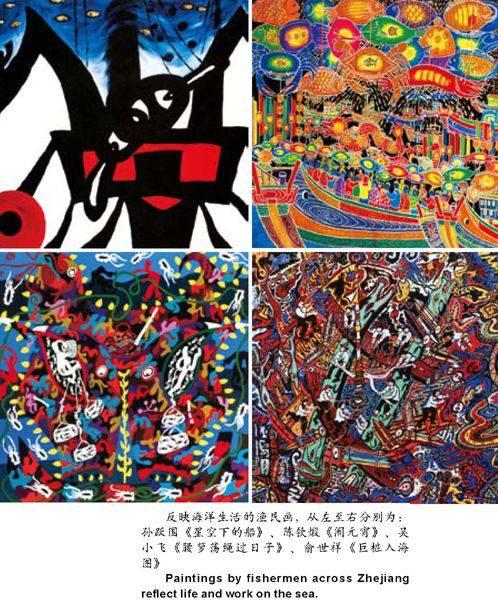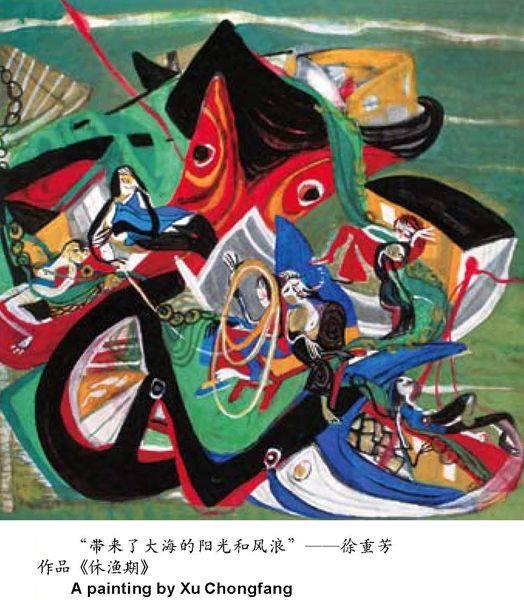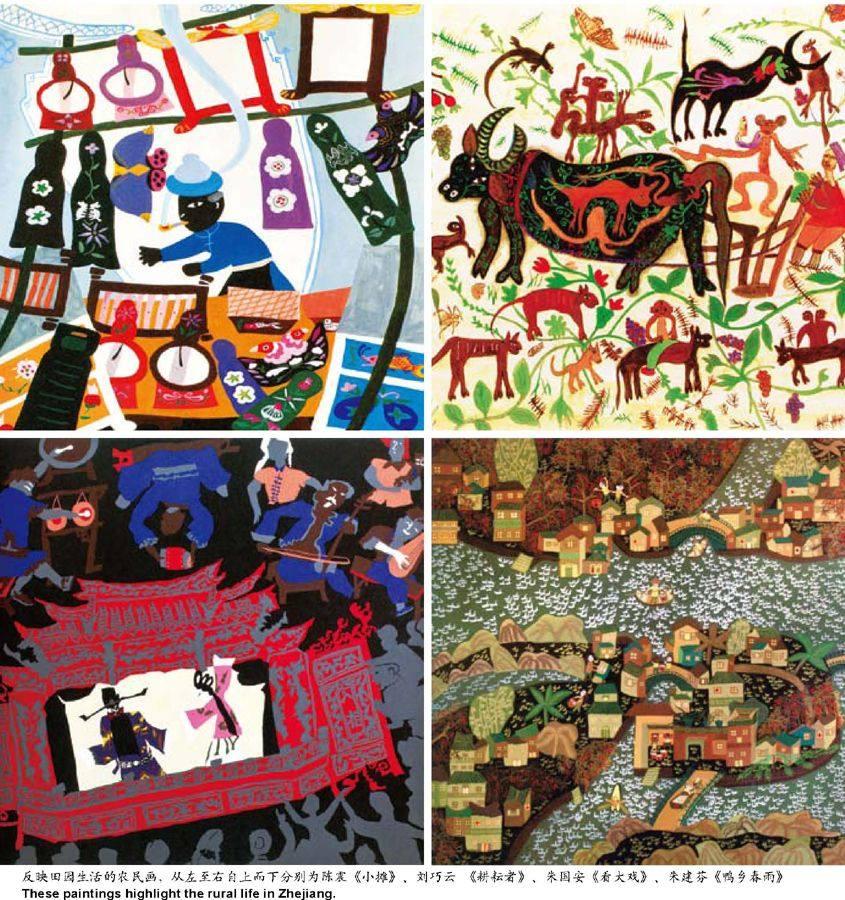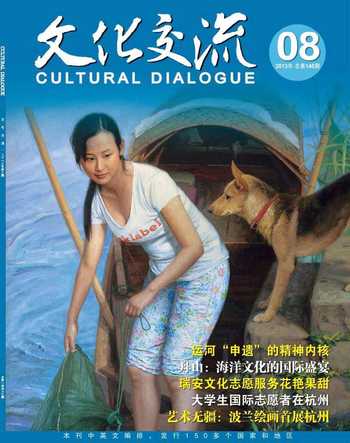观瞻浙江新农民画展
2013-04-29戚永晔
戚永晔



缪惠新被海外艺术界誉为“中国的毕加索”,也被列入“亚洲十位艺术家”之列,他最得意的是这幅名为《乡情》的画作。
Acclaimed as Chinas Picasso and one of the top ten Asian artists, Miao Huixin is proud of his Home Nostalgia.
农历六月的杭州,闷热多雨。唯一能让人觉得一丝神清气爽的,大概只有抽空去城市的各处欣赏艺术品。
在浙江美术馆,我在一幅作品前驻足:这是江南的水乡,雪白的鸭子在密密的河道里悠闲嬉戏,周围是鹅黄色小桥、人家,莫名的亲切扑面而来。细细看之,却不似传统的手法,画作以素描切入,继而上色,只以蜡笔或彩笔之类的画具直接“涂鸦”,奇怪的是,并无任何断节、不和谐之处。
我把征询的目光投向文字介绍的看板,才知道,原来这是嘉兴秀洲农民画家朱建芬的作品《鸭乡春雨》。
而这场浙江新农民画展览的主角,是十位浙江优秀农民画家。主办方为画展取了一个贴切、又富于诗意的名字:水生土长。
水生之事:传承原色文化
在画展现场,我幸运地遇到了中国美术学院院长,也是这次画展的主办方浙江省美术家协会的主席—许江。
谈起这次画展举办的缘由,许江就回忆起3年前的故事来:当时,也是在浙江美术馆,一次全国农民画展正在举办。作为嘉宾出席的许江,正站在展厅的尾端,赞叹几幅大胆而狂野的彩画,忽然脑后传来一个粗酣的嗓门:“许院长,咱们去喝酒!”
一位粗犷的汉子正扎着马步向他嚷。
“这便是渔民画家徐重芳。站在那里,就带来了大海的阳光和风浪。我知道自己遇到了酒神。”这个瞬间让许江永久记忆,而浙江农民画家的形象在他脑海里烙下了深刻的印记。也是从那时起,许江萌生了办一场浙江人自己的农民画展的想法。
徐重芳的名字,我听闻过多次:先是2010年,全国十大民间绘画画家名单揭晓时,一位专业画家对他的作品评价道:“结构、用线、用色无章可循,甚至肆无忌惮,画面瑰丽超群,斑斓脱俗。”这样的话语落在一位只有小学学历的渔民身上,堪称传奇,可不让人心生敬仰与好奇。
后来,2012年,我前往舟山采写海洋文化的稿件,我知道了这位出生于1943年、家乡在定海金塘的老渔民的故事:他曾经经历过海上渔民生活,积累了丰富的创作素材和想象空间。可我没见到他,只能想象他那充满天赋、洒脱不羁、原乡原味的形象。
在这次画展上,我见到了徐重芳。在谈到对绘画的理解时,徐重芳觉得,构思是最重要的:“除了有真挚的情感、夸张的造型、绚烂的色彩外,更需要独特的构思才能令人眼睛一亮。”徐重芳说,他有一幅作品,讲述的是上世纪90年代初,村里男人出海捕鱼,结果渔船不幸沉了。尽管就是简单地想表达家人对失去亲人的痛苦和村民对此的同情,徐重芳却迟迟无法构思出该怎样将这些内容在画纸上表现出来。后来,他用了近20年的时间来思索,最终才得以创作完成这幅《渔岛之夜》。
与徐重芳一样,浙江渔民画家不少都有过亲身出海捕鱼或是与渔民朝夕相处的经历。这次画展的10位农民画家,有5位来自舟山、1位来自洞头。他们对渔家生活的理解就像艺术一样艳丽鲜活。再经过长时间的积累和构思,怎么能不画出好的作品呢?
而这,也是“水生”两个字的由来,发展到如今,浙江多地的渔民画已经形成群体气候,不仅成为当地农民致富的新途径,还成了当地发展旅游文化的品牌。譬如舟山,当你踏上东海最东面的东极列岛,当地渔民会自豪地告诉你,最艺术的地方是渔民画创作室。
土长之情:画出斑斓艺术
和未曾谋面、只慕大名的徐重芳不同,这次画展中另一位“重量级”画家,我在几年前就曾听他侃侃而谈。他叫缪惠新,来自嘉兴秀洲的优秀农民画家。
2010年,我去嘉兴参加当地每年一度的“秀洲·中国农民画艺术节”,第一次认识了脱胎于传统年画、灶画、剪纸、刺绣的秀洲农民画。在艺术节上,展出了上千幅或瑰丽、或淡雅、或明媚、或古朴的农民画,内容大都是水乡农民生活中的锅碗瓢盆、鸡鸭鱼羊、捕捞耕种、婚丧嫁娶,虽然平凡,却让人倍感亲切。
在那次活动上,我到缪惠新的画室里参观。这位个子不高、讲话文绉绉,却又让人觉得稳重踏实的画家,一一为我介绍了他的作品。从画风来看,他的笔调和多数农民画家的淳朴不同,让人觉得已经渐渐结合了西方元素,尝试用造型上怪诞、夸张、奇幻、抽象的手法和艳丽色彩来表现现实的生活。缪惠新最得意的作品是一幅名为《乡情》的画作,背景是江南水乡,画的主体部分是一位农妇的发髻,大块的墨色嵌以红色小块、蓝色细线,视觉冲击力很强。围绕发髻,点缀着稻穗、树木、家畜、日、月、蚕、鱼等,分别对应着农、林、牧、副、渔各业。
事后我才知道,原来画风独特的缪惠新,已经算得上国内首屈一指的农民画家,代表作《乡情》曾多次获得国际大奖,而他本人,也被美国《时代周刊》列入“亚洲十位艺术家”之列,被海外艺术界誉为“中国的毕加索”,并在法国、美国多次举办个人作品展。
今天,在“水生土长”新农民画展上,我又一次看到了《乡情》,见到了缪惠新。他一如既往的谦逊,他说:“我的作品只是如实地将深耕于乡村的美,用画笔画下来而已。今天,我的内心很温暖,农民画一路蹒跚走来,首先要感谢的是各界的呵护。”
“他们并不是传统意义上的农民—‘乡野村夫,他们是扎根于农村的艺术家,同样吸收着全球化时代来自于世界各地的艺术养分,不断与时俱进地进行着创作。农民画为什么感人?因为一种没有功利的、原发性的热情,希望这种原始的感情能够保留下来。”这是许江院长的话。
如他所言,以缪惠新为代表的新农民画家,在传承原生态的同时,已经慢慢走上了国际化的大舞台。他们不受任何形式的束缚,创作上有着很大的自由空间,这正是由于对生活的爱才会引发的创作上的冲动。在现代社会高速化、技术化的背景下,这才是艺术的动力之源。
(本文图片由作者提供)
Rural Artists Display Their Imagination
By Qi Yongye, our special reporter
For me, the best way to escape the hot damp days of June in Hangzhou is to escape to art exhibitions. That is how I find myself stroll into Zhejiang Art Museum and admire masterpieces by ten self-made rural artists. The exhibition is aptly called Out of Water and Earth.
I meet Xu Jiang, president of China Academy of Art and chairman of the Zhejiang Artists Association, which is also the sponsor of the exhibition. The inspiration for the exhibition had come to him three years before while he was visiting a national exhibition featuring artworks by rural artists across the country at Zhejiang Art Museum. While admiring a painting in extremely bold colors, he suddenly heard a loud voice behind him, “President Xu, lets go and have a drink.” Turning his head, he saw Xu Chongfang, a fisherman-turned artist. Standing there, the rough-looking artist brought all the sunshine, winds and waves of the sea into the exhibition hall. At that moment Xu felt as if Xu Chongfang were the very incarnation of the god of wine. That moment inspired him to envision an exhibition for rural folk artists of Zhejiang at the museum.
It is not the first time that I heard of the name Xu Chongfang. In 2010, Xu Chongfang was voted one of the top ten rural folk artists of China. A professional gave such a comment: “Composition, line, and color in his art follow no rules at all. They are unscrupulous and unbridled. The result displays an overwhelming grandeur. Such an analysis might not fit a fisherman who has only primary-school education, but it certainly inspired my curiosity.
I visited Zhoushan Archipelago in 2012 to write an article on local sea-centered culture and learned more about Xu Chongfang. Born in 1943, Xu Chongfang had worked as a fisherman on the sea for decades before he turned to express himself in art. His wild imagination and themes can be traced to what he experienced on the sea during these decades. But I did not have a chance to see him during my visit.
It is at the exhibition this time that I finally meet Xu Chongfang. We have a conversation. When we are talking about how we understand art, Xu Chongfang says originality matters most. “In addition to authentic feeling, exaggerated form, bright colors, originality is what makes ones eyes shine,” he observes. One of the paintings he created is about the sinking of a fishing boat in the early 1990s. The men who died in the sinking were all from his village. He had wanted to create a painting about the tragic losses, but he failed to find a way to express pain and sympathy in image. It was not until nearly 20 years later that he found a way to do it.
Zhejiang has many rural artists who once fished on the sea. Of the ten representative artists at the exhibition, five are from Zhoushan Archipelago and one from Dongtou, an island county in southern Zhejiang. They are partly described by the title of the exhibition: they grow out of water. Nowadays, artists of the sea across Zhejiang are a phenomenon. Many make a living out of their art and their art is part of local tourism.
Another heavyweight rural artist featured at the exhibition is Miu Huixin from Jiaxing, whom I first met in 2010 while I was covering an annual folk art festival in Jiaxing. At the event were about 1,000 paintings by rural folk artists, featuring everyday life and work in villages. I visited Miu Huixins studio while I was in Jiaxing. A middle-height man who uses some highbrow words and phrases in his talk, he pursues his art in a different way. Most fellow folk artists prefer an unadorned style that offers simple charm. He incorporates western elements into his paintings: absurdity, exaggeration, magic, abstraction can be found in his portrayal of his imagination and his understanding of everyday life. Home Nostalgia, his masterpiece, is widely recognized internationally. He has held solo exhibitions in the United States and France.
Xu Jiang comments that these artists are not farmers or fishermen in the traditional sense of the words: uneducated louts living in rural wilderness. They are fine artists with their roots in rural areas. While retaining the rural quintessence, they are gradually known internationally. Not confined to conventional dos and donts in art, they have created a space for their imagination.
